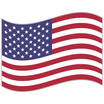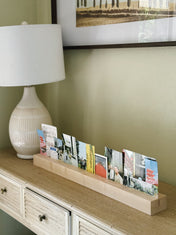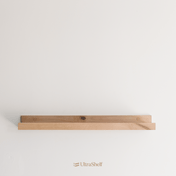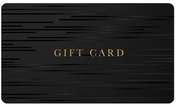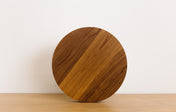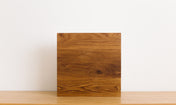Patterns are one element of interior design where it’s easy to get tripped up. With so many options and pattern variations available, it’s tricky to know which patterns to use where and how to mix patterns with other patterns in your home and the existing design.
Pattern can be created by repeating elements in your home, which is definitely something to consider when designing your space. For example, right now we are looking to pick a printed pattern for a custom headboard in our bedroom. The wall behind our bed features a subtle board and batten with thin, vertical strips of wood. The repeating element on the wall creates a pattern in the space that can’t be ignored when picking a patterned fabric for the space.
If we pick a striped pattern for the headboard, it would have to be a smaller version of the stripe pattern that’s created on the wall behind it so as not to compete. But we’ll have the best luck picking a more organic pattern to compliment the strong lines on the wall and soften the room. Here are the patterns we’re considering:

One of the first steps to picking patterns though is getting familiar with popular patterns that you will see printed on textiles. There are so many different patterns and variations of those patterns out there that it often feels overwhelming to take on the task of becoming a pattern pro. Lucky for you though, we’ve rounded up a list of the most popular patterns in interior design. This list will help you get familiar with the patterns you need to know when designing your home.
Checkered
The checkered pattern is pretty self-explanatory. We love checkered patterns because there are endless variations of a classic check that make this pattern so applicable to many design styles. Simply by changing the color or the scale of the pattern, you can take a pattern that you traditionally see in farmhouses and make it funky and modern.
You may also see this pattern created on floors using alternating floor tile colors to create a checkerboard floor in a kitchen or laundry room. A checkered floor feels instantly fun and classic to us.

Brocade
Brocade is a traditional pattern that is usually very ornamental. When you see traditional brocade fabrics and textiles, the pattern is usually woven in, and you’ll see this weaving done in gold and silver more often than not. The modernized version of brocade is a lot more common and one of our favorite ways to elevate a space without making it feel stuffy.
Modern brocade often imitates the popular brocade patterns but creates them using a different method, like block printing. And while this does mean it’s not technically brocade because it’s not woven in — for the sake of simplicity, we still count it.
Chintz
If a pattern automatically makes you think of an English Countryside aesthetic or traditional American Farmhouse, chances are the pattern is considered chintz. Chintz runs the gamut but is essentially intricate and elaborate florals. This pattern lends itself very well to grandmillenial decor and was made hugely popular by designers like Nancy Lancaster.

Basketweave
One of our favorite symmetrical patterns, basketweave is a pattern that imitates the look of a woven basket. Now basket-weave textiles can be woven, or they can be printed on, either way, it's the look of the textile that makes it basketweave.
We love basket weave because a tight basket weave almost passes as a neutral. We have several basket weave rugs around our home, and we love that you can't see the pattern until you get up close. It's a great way to add patterns to the home without adding something super busy.
Gingham
Sometimes lumped in with plaid or checkered fabrics and patterns, gingham is actually a pattern all of its own. Sometimes referred to as a picnic blanket pattern, gingham is a combination of three colors that create a more complex checkered pattern. The colors are usually white and second color in two variations — in the picture above the three colors would be white, tan, and light tan.
Gingham is popularly used in clothing, but in the home, you will see it quite frequently in textile accents or as wallpaper.

Ditsy
Ditsy patterns are typically very small and organic. There aren't usually lines or notable patterns throughout the textile, there's definitely an element of randomness or chaos to a ditsy pattern. Ditsy patterns are usually florals, but not always. This tiny pattern still packs a punch, so if you’re looking for a big impact try something ditsy.
Floral
Floral is another really self-explanatory pattern class, if it's got flowers on it it's considered floral. Now, we've talked about things like ditsy florals and chintz — patterns that use floral elements and would be considered a floral pattern — but more accurately considered ditsy or chintz based on the size and intricacy of the florals. So, while not all floral patterns are ditzy for chintz, many ditsy and chintz patterns are considered floral as well. Did we make that confusing enough?
If you’re in the market for florals, check out stores like Anthropology, Rifle Paper Co, or places that sell William Morris designs.

Damask
Damask is another very popular traditional pattern. Our girl, Martha Stewart, happens to be a big connoisseur of this pattern. Featuring ornate shapes and swirls, and usually in a jewel tone with some gold or silver thrown in, damask feels very high-end and traditional. Damask definitely has a flair for the dramatic and because it’s so print-heavy, it’s going to command a lot of attention wherever it’s displayed.
Greek Key
The Greek key is the pattern commonly associated with Greek design and architecture. You're going to see this pattern throughout Greek architecture in famous buildings and in Greek homes — and it's the pattern are you going to see in Greek textiles as well. And while the Greek Key pattern isn't the only popular pattern of Greek origins, it is the most easily recognizable and the pattern that has spread farthest around the world.

Geometric
Geometric patterns are another group of patterns that is pretty broad. Patterns that don't fall under other categories, and that use strong lines and shapes – either alone or repeating – would be considered geometric. It's pretty easy to identify geometric patterns, just think about the basic shapes you learned in your high school geometry class, and if you can easily identify those shapes in your pattern, you're likely looking at a geometric pattern.
Geometric patterns are definitely popular in textiles, but you're going to see these a lot in floor and tile designs. Start paying attention to the spaces you occupy, there's a really good chance that there are reoccurring geometric patterns in your home right now.
Chevron
As the pattern that had a chokehold on the mid-2010s, chevron is easily recognizable. Every college dorm room had at least three chevron bedspreads in 2012. And while you're likely to associate this pattern with textiles, chevron is actually a very common wood floor pattern that takes its roots in very traditional style and dates back hundreds of years. Chevron pattern is made up of alternating lines to make an exaggerated zigzag.

Harlequin
Harlequin patterns are one of our very favorite patterns. Similar to a checkerboard, Harlequin patterns use diamonds instead of squares. To us, Harlequin patterns feel very elevated and sophisticated, but with an element of fun. You can find these patterns in textiles, but also in finishes in your home, like the floor. Depending on the color of the Harlequin pattern, you can end up with something that feels really classic or something that feels very whimsical.
Elevate your space with Ultrashelf's custom floating shelves—where elegance meets functionality. Tailor your surroundings to your style with our unmatched customization, precision, and quality. Don't settle for the ordinary. Transform your environment today.

